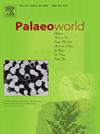Paleoenvironmental records across middle to Upper Cretaceous in central part of the West and Central African Rift System: Palynological and geochemical inferences
IF 1.7
3区 地球科学
Q2 PALEONTOLOGY
引用次数: 0
Abstract
The West and Central African Rifts System (WCARS) is well-known for its Cretaceous deposits. Still, the reliable dating of sedimentary successions, especially in the central part, and the mechanisms causing environmental and climate change over time remained less explored. Two sections of exposed deposits were investigated within the Babouri-Figuil Basin, specifically along the Mayo-Figuil (MF) and Mayo-Dakmoune (MD) rivers. The deposits are primarily composed of wackes formed from felsic and intermediate parent rocks, perhaps originating from the adjacent basement rocks, although there are also mafic components represented by an iron-rich shale layer at the MF section. Relative dating has constrained the MF sediment age to the Albian–Cenomanian and the MD sediment age to the Campanian–Maastrichtian. Using whole-rock organic matter geochemistry and trace element concentrations, we discovered anoxic conditions, well-preserved organic matter, and marine salinity water occurrence in the Albian–Cenomanian deposits, probably related to the first Trans-Saharan seaway. Oxic conditions, poor-preserved organic matter, and brackish salinity water occurrence were established during the Campanian–Maastrichtian. The Hg/TOC spike recorded during the Albian–Cenomanian could be the consequence of proximal volcanism, most likely associated with enhanced rifting tectonic activity, whereas the maximum Hg/TOC ratios observed during the Campanian–Maastrichtian could be the product of distal volcanism. Globally, weathering was slow to moderate, and the climate was interpreted as semi-arid throughout the middle to Late Cretaceous in the central WCARS.
西非和中非裂谷系中部中、上白垩世古环境记录:孢粉学和地球化学推断
西非和中非裂谷系统(WCARS)以其白垩纪沉积物而闻名。然而,沉积序列的可靠定年,特别是在中部地区,以及导致环境和气候随时间变化的机制仍然很少被探索。在Babouri-Figuil盆地内,特别是沿Mayo-Figuil河(MF)和Mayo-Dakmoune河(MD),研究了两段暴露矿床。该矿床主要由长英质和中质母岩形成的碎屑组成,可能起源于邻近的基底岩,尽管在MF剖面也有以富铁页岩层为代表的基性成分。相对定年将中程沉积时代限定为阿尔比亚-塞诺曼尼亚沉积时代,中程沉积时代限定为坎帕尼亚-马斯特里赫特沉积时代。利用全岩有机质地球化学和微量元素浓度,我们发现了阿尔及利亚-塞诺曼尼亚矿床的缺氧条件、保存完好的有机质和海洋盐度水,可能与第一次跨撒哈拉海道有关。在坎帕尼亚-马斯特里赫特时期,建立了缺氧条件、保存较差的有机质和微咸水的赋存。在阿尔巴尼亚-塞诺曼尼亚时期记录的汞/TOC峰值可能是近端火山活动的结果,最有可能与裂谷构造活动增强有关,而在坎帕尼亚-马斯特里赫特时期观察到的最大汞/TOC比值可能是远端火山活动的产物。在全球范围内,WCARS中部中白垩世至晚白垩世的风化过程为缓慢至中度,气候为半干旱。
本文章由计算机程序翻译,如有差异,请以英文原文为准。
求助全文
约1分钟内获得全文
求助全文
来源期刊

Palaeoworld
PALEONTOLOGY-
CiteScore
4.00
自引率
5.90%
发文量
95
期刊介绍:
Palaeoworld is a peer-reviewed quarterly journal dedicated to the study of past life and its environment. We encourage submission of original manuscripts on all aspects of palaeontology and stratigraphy, comparisons of regional and global data in time and space, and results generated by interdisciplinary investigations in related fields. Some issues will be devoted entirely to a special theme whereas others will be composed of contributed articles. Palaeoworld is dedicated to serving a broad spectrum of geoscientists and palaeobiologists as well as serving as a resource for students in fields as diverse as palaeobiology, evolutionary biology, taxonomy and phylogeny, geobiology, historical geology, and palaeoenvironment.
Palaeoworld publishes original articles in the following areas:
•Phylogeny and taxonomic studies of all fossil groups
•Biostratigraphy, chemostratigraphy, chronostratigraphy
•Palaeoecology, palaeoenvironment and global changes throughout Earth history
•Tempo and mode of biological evolution
•Biological events in Earth history (e.g., extinctions, radiations)
•Ecosystem evolution
•Geobiology and molecular palaeobiology
•Palaeontological and stratigraphic methods
•Interdisciplinary studies focusing on fossils and strata
 求助内容:
求助内容: 应助结果提醒方式:
应助结果提醒方式:


